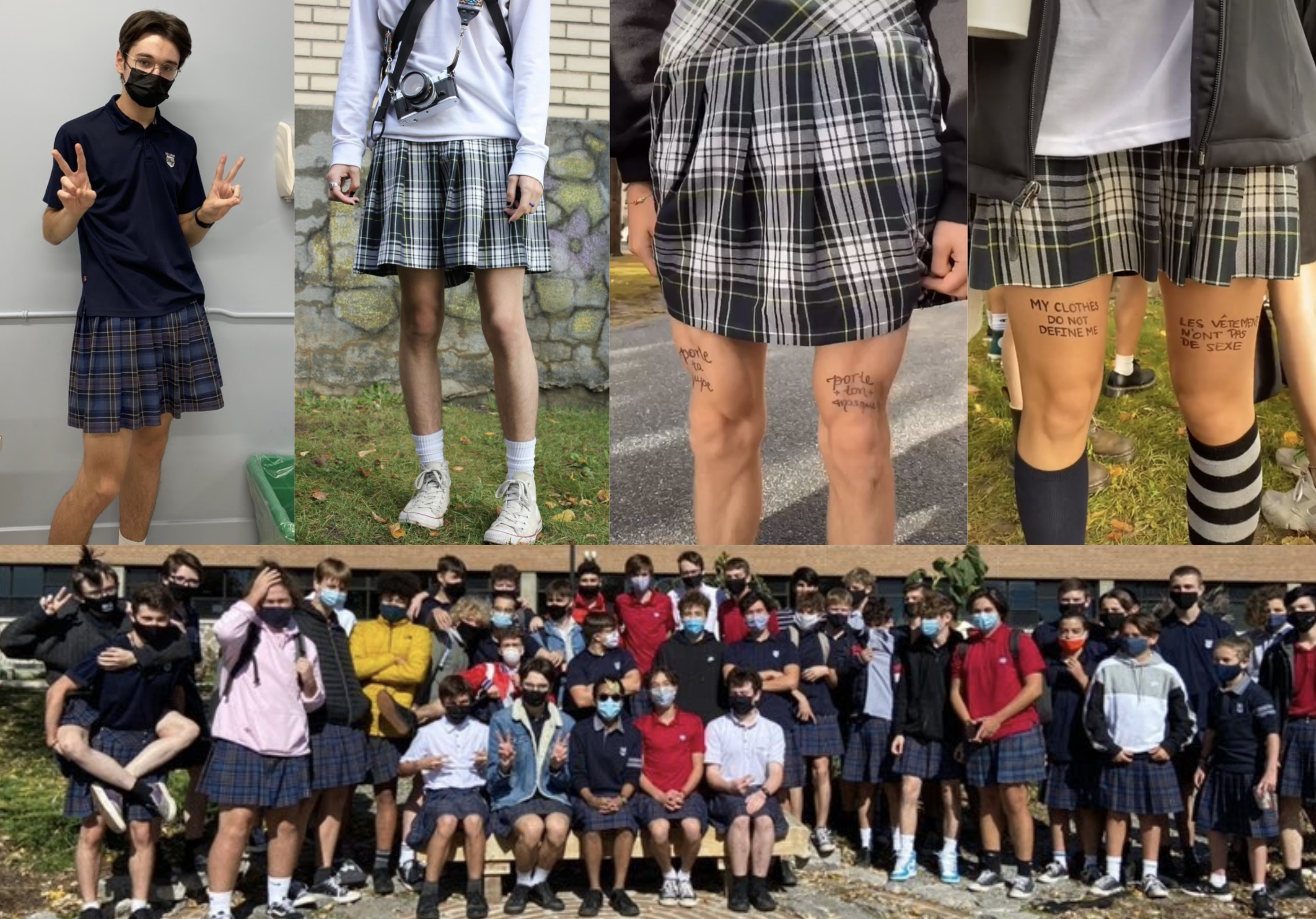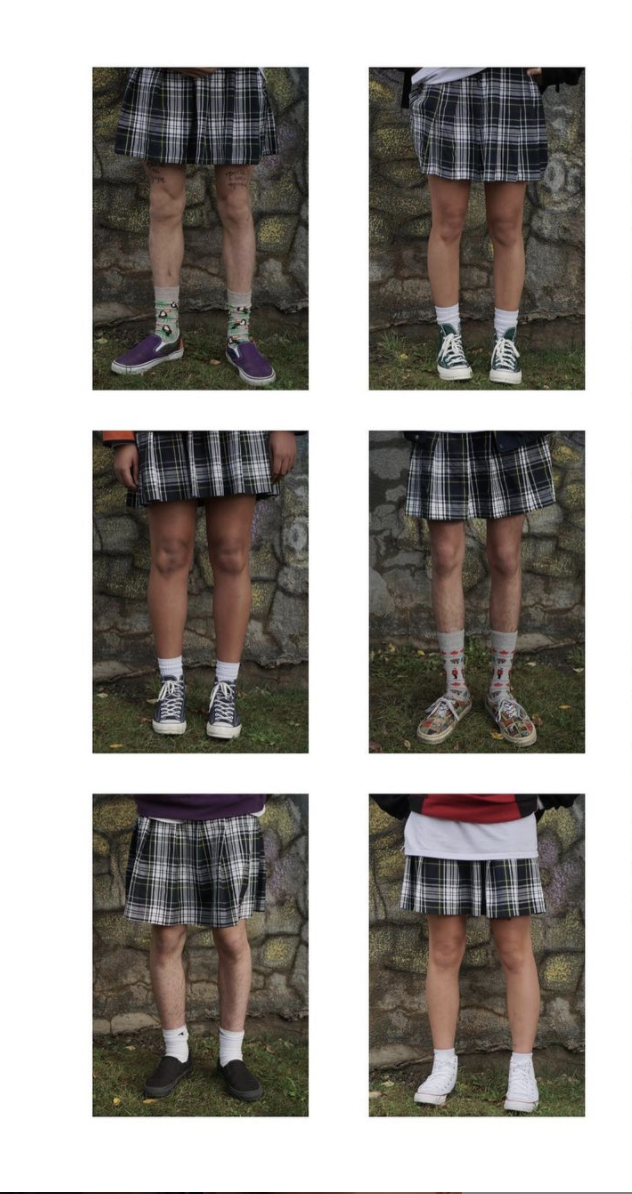Students across secondary schools in Québec, Canada have been donning skirts to stand against dress code regulations that they label sexist. School regulations in the province require that girls must wear skirts that are a certain length above the knee, but there is no comparative rule for the uniforms that boys must wear. These gendered rules unfairly target female students and isolate nonbinary students, students argue.
These protests are popular in high schools, and across the province as a whole. Colin Renaud, a 15-year-old co-porte parole (co-spokesperson) of Cercle Mauve (Purple Circles), an organization launched for the movement at his school of Villa Maria, “In my school [roughly] 20 persons protested but I think that in all the province of Quebec at least 10,000 boys protest against sexualization of the woman body and toxic masculinity.” Roxanne Lefson, a student at Royal West Academy in Montreal, explained that she sees the cause as something that is very important to their generation, and hopes the movement will carry on beyond their area, saying, “I was so proud to see my friends go out of their comfort zones to stand up for what they believe in and I sincerely hope that this protest reaches other areas around the country and the world and that it makes a difference when it comes to the over sexualization of women’s bodies and helps increase the comfort level of men and non-binary people who currently don’t feel safe wearing more ‘feminine’ (or what society has deemed as feminine) pieces of clothing.”
Organization of the protests varied by institution. Tyler Brosseau, who attends Collège Durocher Saint-Lambert on the South Shore of Montreal, said that at his school “no one really organized them, it was more of a collective initiative.” The power of social media was used to harness and energize protests, utilizing a less structured network to carry out the demonstrations for the cause. A student at the Royal West, Thomas, explained, “The leadership is pretty decentralized and there isn’t much traction outside of Quebec.” He said that boys at his school became interested in the movement, but that “the girls started convincing other guys and started planning out logistics.” Another student at Royal West, Justin, explained that the lack of formality does not make the movement’s momentum any less valuable, saying, “I don’t think this protest is close to over and that we have to continue to fight and try our best to continue spreading awareness and changing people’s opinions for the better on this topic.” Similarly, Brosseau continued, “We won’t let that put the movement to an end though! There will be more days students will be encouraged to wear skirts until the school provides us with the change we demand.”
https://www.tiktok.com/@ticapomi/video/6880993873380855042?_d=secCgsIARCbDRgBIAIoARI%2BCjyDhrshhMLtAJ5K5BjyF%2FHE%2FLdKzXA0RVPRJrBu15fQlENNZx71qukOCfhtx07l36cm1xjcLUyMk%2BUhBREaAA%3D%3D&language=en&preview_pb=0&sec_user_id=MS4wLjABAAAAmW8SWFvnJZia4ZdOvVXNoDsxjAXXDLFoQq9D3Mlsky9wWcEi3TQKd_carvotjes1&share_item_id=6880993873380855042&share_link_id=E2B41C7D-42CD-42CE-A248-0A62C674DB5D×tamp=1603856574&tt_from=sms&u_code=d309m3gf8hgad5&user_id=6618629334116761606&utm_campaign=client_share&utm_medium=ios&utm_source=sms&source=h5_m
Video courtesy of Sara Mboqe (@ticapomi) on Tiktok
Some school administrations are warming up to changes better than others. Students at L’École d’Éducation Internationale in McMasterville began the protesting movement in Québec after growing frustrations regarding uniform rules, simmered over. This sparked a wave of action across the province. According to other students who have picked up the movement, the L’École d’Éducation International administration has doubled down on the policies and cracked down on protesting.
Maïka Sylvestre, a secondary V student at Durocher Saint-Lambert, shared that what the administration did leading up to the protests is what encouraged her support of the moment, “I feel like our school administration was always telling the girls students that if their skirts was over five cm above their knees, it was considered like a form of distraction for the boys. In our society, young women have been hypersexualized for ‘showing’ too much skin, which is disgusting. Which led me to protest against it. I feel good protesting as a young woman because if I want change in our society, I have to take action. I feel that the uniform rules at my school are not made for everyone since we have to choose between the girl and boy category of clothes.” Sara Mboqe, also at Durocher Saint-Lambert said that her school regulations are yet to be changed, but they didn’t face extreme backlash, “They were pretty supportive of the idea, but however the rules concerning the uniform (the acceptable length of the skirt and the fact that boys aren’t allowed to wear skirts) still haven’t changed, but we’re hoping to work on it…”

Image courtesy of Zachary Paulin
Brosseau said, “Faculty members took it lightly, some even encouraged the movement, but the school administration just thought of it as a one-day thing against sexism (which is one of the many things it is) and no change was made.” Benjamin Savard at Durocher Saint-Lambert expressed serious frustration with the school, as time passed. He explained, “Some schools would be openly against it, but my school reacted well at first. They made a statement saying how they were proud of their students and that they backed the movement. However, I have a friend a year younger than me, Justin Rivard, who decided to wear a skirt to school today, about a week after the day that everyone did. He was the only person in his year to do that and was forced by the faculty to remove it and put on pants. He was told: ‘the movement is over you should not be wearing it anymore.’” However, peers at Durocher Saint-Lambert expressed hopefulness about a new committee to review the uniforms. Renaud, at Villa Maria, did not share about any sort of peer board at his school, though he also expressing disappointment in his school. He shared that his directors were quick to provide “excuses for the person who [directed] homophobic and transphobic speech” at him.
Brosseau shared that faculty members were more encouraging than the administration as a whole, which believed it to be more of a momentumless demonstration, “Faculty members took it lightly, some even encouraged the movement, but the school administration just thought of it as a one-day thing against sexism (which is one of the many things it is) and no change was made. we won’t let that put the movement to an end though! There will be more days students will be encouraged to wear skirts until the school provides us with the change we demand.” Renaud’s Cercle Mauve, which was launched by fellow students Marine Pichette and Avril Arce but revitalized with Renaud through the protests, even has a specific list of objectives for the movement at their school, just across the St. Lawrence from Brosseau’s, “1) Inform people about the feminist movement particularly about sexist uniform; 2) [Make men aware] about toxic masculinity and sensitize them; 3) Desexualize women’s bodies.”
Video courtesy of Roxanne Lefson (@roxlefson on TikTok)
For these young people, uniforms are a mark of a larger issue of hypersexualization and discrimination. 16-year-old Zachary Paulin at Nouvelles Frontières College in Gatineau, Québec explained, “The protest for me was a way to symbolize the importance of normalizing boys being feminine and boys being comfortable in their true skin. It was also a way for me to denounce the sexualization of women in school institutions, but also in society in general. So as a young man, my main goal was really to bring awareness to these issues; which I found very important.” Thomas shared that the protests opened his eyes to the extent of what he labeled “peer pressure/toxic masculinity,” saying, “I never really hung out with such individuals so I wasn’t all that familiar with how insecure and mean they were.” Raphaël, a student at Durocher Saint-Lambert, shared that a boy used homophobic language, in French, but that students supported him and stood by him.
Brosseau documented the protests, using legs as the subject of his photography to emphasize the a genderless perspective on clothing.He wrote in a popular post on Instagram, “On Wednesday October 7, we, boys and girls, wore a skirt to school. This gesture, which may seem rather banal to some, was shocking to the public…Because the length of a skirt does not validate inappropriate behavior…Who says that clothing must be attributed to a specific sex? That clothing displays the masculinity of the wearer?…We wore a skirt to pass the message that with us, these standards will no longer have their place in our society.” Or, originally, “Le mercredi 7 octobre, nous avons, garçons et filles, porté une jupe à l’école. Ce geste, qui peut sembler plutôt banal pour certains, a drôlement été choquant aux yeux du public… Parce que la longueur d’une jupe ne devrait pas être une devrait pas être une distraction pour ceux qui fréquentent l’école…Qui dit qu’un vêtement doit être attrubué à un sexe? Qu’un vêtement affiche la masculinité de celui le portant?…Nous avons porté une jupe pour passer le message qu’avec nous, ces normes n’auront plus leur place dans.”
Schools argue, like Villa Maria for example, that uniforms create a sense of community and simplicity. On their dress code regulation page they state, “Villa Maria promotes equal opportunities and we believe this means equality in all areas, including the wearing of a uniform. By creating for the students a sense of belonging to their school and with their peers, a school uniform strengthens team spirit and facilitates integration.”
Québec is not the first place to see uniform protests, as skirt demonstrations have cropped up around the world. Young boys in Exeter, England braved cold temperatures in 2017 to push for changes to restrictions. Teens in France used #lundi14septembre, while wearing crop tops in September of 2020 to defy gendered dress code restrictions (not to mention their hijab/veil ban) Some school districts in the US have been moving to gender-neutral dress codes, and simply reduced their enforcement. Different aspects of gendered uniforms in South Korea have been challenged, including legal battles over workplace uniforms, dating back to 2018.
We love a good #Lundi14Septembre
pic.twitter.com/rTRYMPUMPj
— Super Mario 64 DS (@aesthething) September 14, 2020
Savard shared, “I feel boys have been taking too much of the attention during this issue. While the movement is also protesting gender norms I still think the point is to come in support to the women who are living the problem.” The very problems that the protests are attempting to root out have been highlighted by the coverage and reception of the protests. Schools and outlets praise young men for wearing skirts, instead of scrutinizing the experiences of young women and non-binary people that lead to the demonstrations. Dress codes restrict students to the conformity of the gender binary, making the simple task of going to school a display of adherence to the concept of masculinity and femininity. The mere act of wearing a skirt leaves boys labeled as “brave,” because society’s expectations for different genders is so rigid. The very rules of gendered dress codes regard young women as distractions and frame their very existences around making boys more comfortable, under the antiquated and perverse notion that a girl’s body serves as a “distraction,” feeding right into the patriarchy during some of the most formative years in a person’s life (while fully ignore non binary and gender fluid people).
School uniform assignments for girls have no equivalents for boys, and non-binary people are not provided with an option, making getting dressed an exercise in understanding that the privileges afforded to people are dependent on gender identity. The push for protesting helps to demonstrate a sense of awareness and impassioned behavior amongst the young people of Québec and beyond.
Feature images courtesy of Tyler Brosseau (leg images) & Zachary Paulin (left image and group image)












